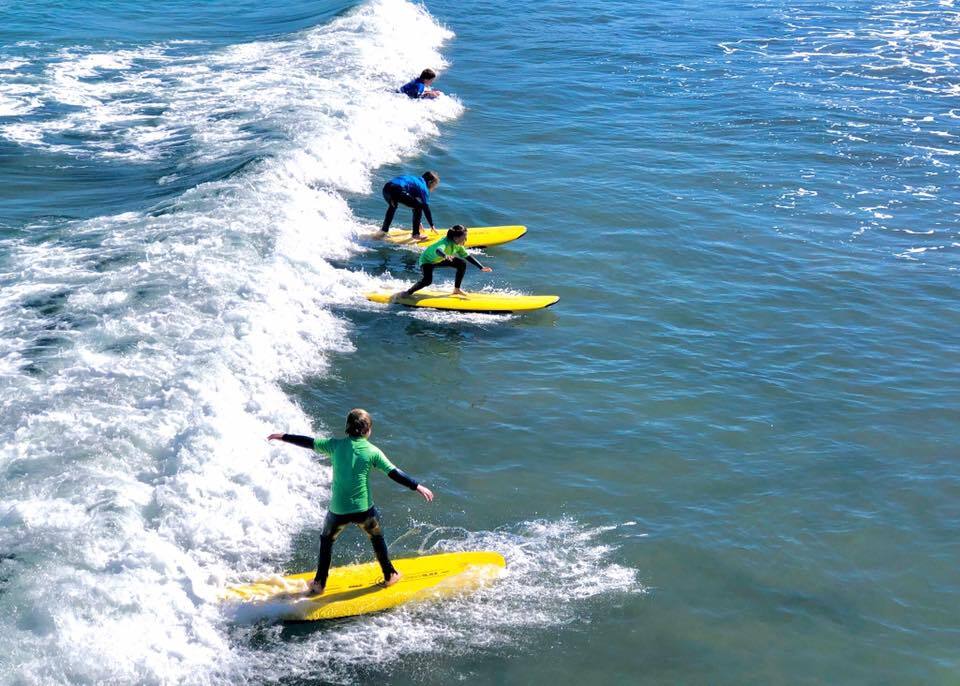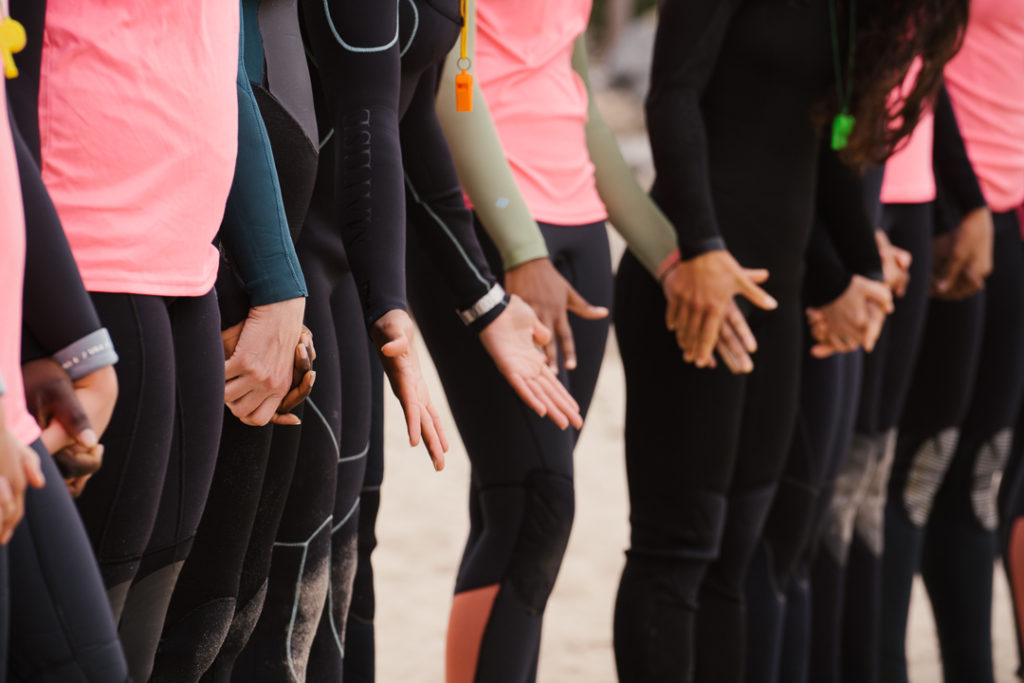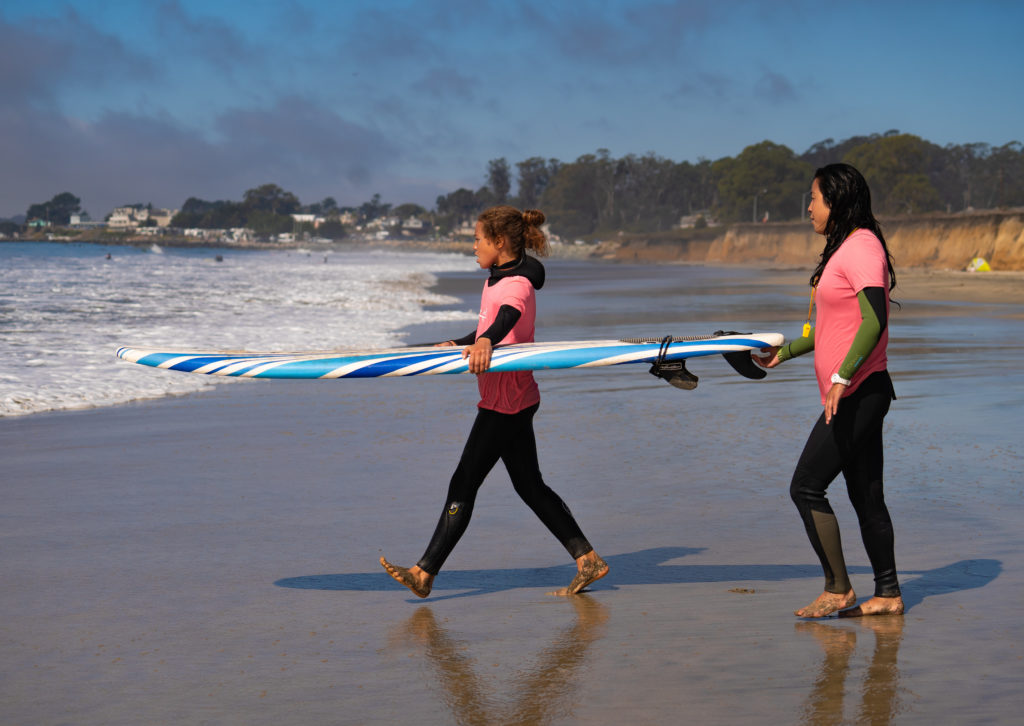When Mira Manickam-Shirley got a job as a naturalist in the Marin headlands, she found herself living by the beach for the first time in her life, and she wanted to learn how to surf.
She remembers a running bit she had with one of her first surf buddies there. “He was always like, ‘Yeah, just look for me, the blonde dude in the water.’ The joke was like, everyone’s a blonde dude.”
But in Manickham-Shirley’s experience, it is a joke that rings true. She’s always been one of the only women and people of color in the lineup — where surfers wait for breaking waves.
The stereotype is somewhat ironic, considering the non-white roots of the sport. In its current form, surfing was pioneered by indigenous Pacific Islanders and may have also been independently practiced by indigenous South Americans. The pre-Incan Mochica people in Peru likely used their reed boats for surfing as well as fishing. In Hawaii, he’e nalu, or wave sliding, dates back to at least the 15th Century. Three Hawaiian princes introduced surfing to California — and North America — when they first paddled out in Santa Cruz in 1885.
Segregated Waves
Growing up, Dionne Ybarra would have had a hard time seeing surfing as anything other than a white sport. From The Beach Boys to Endless Summer to Point Break, popular culture paints a starkly white picture of American beach life — and people who look like her can’t help but internalize that.
Even though Ybarra grew up just a 20-minute drive from the beaches of the Monterey peninsula, she says her Mexican-American family would only venture out to the water once a year, on July 4th.
“There’s this fear set up from birth that we’re not ocean people, we don’t go in the ocean,” she says, referring to people of color in America.
Ybarra’s mom had her take swimming lessons as a kid, but still made her wear a life jacket anytime they were by the water. Ybarra laughs as she remembers the life jacket, describing how it completely undermined the lessons she took.
It wasn’t until Ybarra was an adult — well into her 20s — that she took up surfing, and now she runs an organization that aims to get more young girls of color out in the water.
She started The Wahine Surf Project in 2010 in Monterey. Through working with parents at surf lessons, Ybarra has come to realize that the fear of water her mother exhibited — and a culture of not going to the beach — is common in communities of color.

America’s history of systemic racism plays a major role in discouraging people of color from taking up water sports, according to Chelsea Woody, co-founder of Textured Waves, a surf collective for women of color.
“Segregation laws of this country really restricted who could participate in leisure activities and zoning laws with who could buy land in certain areas and coastal towns,” Woody explains.
The California Land Act of 1851 pulled sprawling ranchos away from Mexican owners and handed them over to white settlers. Pools and beaches were segregated during Jim Crow, effectively prohibiting Black people from public access. A 2014 CDC study found that Black American children were up to 10 times more likely to drown than white children.
“I think the lineup is really just an extension of colonialism,” says Kyla Langen, co-founder of San Francisco based Queer Surf.
Manickham-Shirley notes that racial disparities in wealth, as well as the history of housing discrimination and access to loans, all play into who lives by the beach now. Real estate there is typically more expensive and sought after.
“If you go and look at a lot of housing covenants in coastal properties, contracts about the sale of homes, they literally will say this home cannot be sold to, and then list of various different ethnicities, different races,” she explains.
Surfing is expensive — and not just the equipment. According to a 2011 study by the Surfrider Foundation, American surfers made about 100 visits to the beach every year, and spent $66 per visit. On average, they earned $75,000 a year.
Surf & Turf
Danielle Black Lyons, another Textured Waves co-founder, and Woody, both understand that not seeing people who look like you in the water can be discouraging, but they are also persistent in encouraging people of color to paddle out.
“It may appear that you’re the only one in the space, but, you know, there are other Black and Brown folks around the world that surf and have always surfed,” Lyons notes.
Still, feeling comfortable getting in the water for the first time is also linked to the way the community treats newbies. And veteran surfers don’t exactly have a great reputation on that score.
There are an estimated 2.8 million surfers in the U.S. now. With limited waves to go around, surfers can be territorial, touting an “if you don’t live here don’t surf here” attitude. Fort Point, a wave break just under the Golden Gate Bridge, is notorious for its localism. Back in 2002, three surfers were convicted of fighting a fourth — and leaving him with a broken nose and gashed eye.
While the motivations behind territorial aggression may not be directly linked to the color of surfers’ skin, it often underscores issues of privilege and access. “Localism helps ensure that the people who are already there kind of stay in control,” Manickham-Shirley says. And if the people who are already in wealthier, beachfront communities are more likely to be white, that makes it that much harder for people of color to gain their footing.

While Ybarra’s East Salinas neighborhood was predominantly Latinx, she says the ones dotting the peninsula were — and still are — white. This feeds into a wider narrative of racialized entitlement over land.
Someone at the beach told Ybarra she couldn’t park there, and Langen’s car was keyed outside a surf break when she first moved to Santa Cruz.
“I think it was just, you know, a new person showing up who is kind of competent and can surf and that’s threatening. That’s threatening to a local… who feels this like deep entitlement because of their whiteness and their privilege. And the fact that they probably own a house close by.”
Tough Guys
Langen describes lineups as often having a hyper-masculine energy to catch and “dominate” every wave. It’s an attitude that can — and often does — fuel misogyny and homophobia.
“I think a lot of women surfers will say that, when you’re a woman surfing, every wave you have to prove yourself,” Manickham-Shirley says. She notes that the added pressure to gain respect in the lineup comes from others assuming that women just can’t surf.
Langen competed professionally for 12 years, spending a chunk on the World Surf League (WSL) Tour. She says that while the tour was an incredible chance to surf and travel — and get paid doing both — it was also suffocating.
“We couldn’t just be athletes. We had to be the models for the companies. We had to wear our hair down when we surfed,” Langen says. While men spent their photoshoot days out surfing, women often stayed on the beach in full makeup.
Gay women felt pressure to hide their sexuality to stay more marketable for surf companies. Romantic partners were, in public, platonic travel buddies. The same went for gender expression. “If we wanted to get paid or if we wanted to get sponsored, we had to be as femme as we could be,” she says.
There was significantly less of this pressure when Langen moved to the Bay Area. She made more queer friends, and many said they had always wanted to surf but felt too intimidated to try. What started out as taking them surfing turned into formal lessons and retreats for queer, gender non-conforming, trans, and non-binary people. Langen officially founded Queer Surf in 2016. Showing up in groups, she says, has been helpful in queer folks feeling more safe and comfortable.
Having access to equipment, getting to the beach and into the cold water, overcoming any past trauma with the ocean, and dealing with aggressive locals are just a handful of the obstacles to surfing in the Bay Area. “It’s just such a privilege to be able to go to the ocean and be at the ocean and it’s a shame that it’s a privilege that’s often reserved for straight white folks,” Langen said.

Manickham-Shirley co-founded Oakland-based Brown Girl Surf with Farhana Huq back in 2011. They wanted to carve out space for women of color in surfing, and Manickham-Shirley says that the most rewarding part of her job is sharing the joy and freedom she feels in the water.
Natalie Small, founder of San Diego-based Groundswell Community Project, a nonprofit providing surf therapy for women with programs in the Bay Area, describes the ocean as a therapeutic place to play and find community. They’re currently working with UCSD researchers to better understand shifts that happen through surf therapy — like emotional regulation, self-awareness, and resilience.
“When we surf we’re really reclaiming ourselves and our sense of power, our sense of intimacy, our ability to be safe, strong, and our ability to connect with others and the world around us,” she explains.
Ybarra loves revisiting that sense of excitement with every surf session. “You just see kids who say, this is the best day of my life,” Ybarra says. “And there are these Black and brown children who I know took like 45 minutes to get here and they’re in a suit that’s sort of funky and they don’t care and they are just bursting at the seams with feeling.”
Emily Zhang is an intern at SF Weekly. She covers arts and culture.





Recent Comments